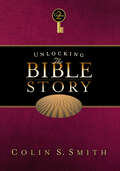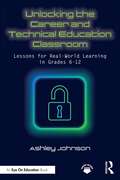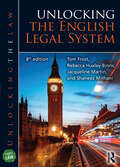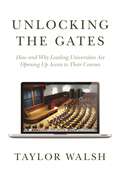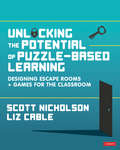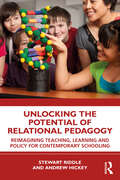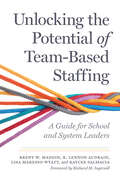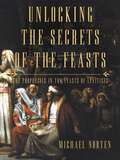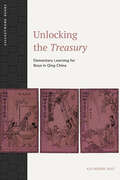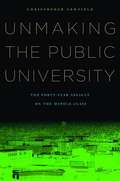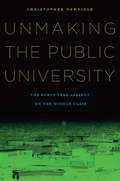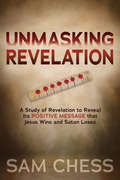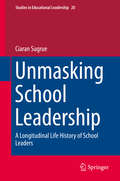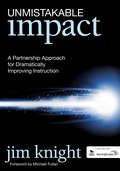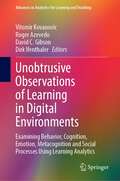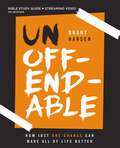- Table View
- List View
Unlocking the Bible Story: Old Testament Volume 2 (Unlocking The Bible Ser. #2)
by Colin S. SmithFor all who are wondering how the pieces fit into the jigsaw of God's revelation, Colin Smith has provided an answer, which is refreshingly simple, biblically accurate, and will prove phenomenally helpful to the serious Bible student and the new beginner alike. — Alistair Begg, senior pastor, Parkside ChurchIn Unlocking the Bible Story, Colin Smith moves gradually through portions of the Bible to explain how it all holds together. He tells God's one grand story of salvation and reflects on major themes along the way. In volume 2 he moves through the Wisdom and Prophetic books, which provide reflections on life with God, judgment for sin, and the hope of restoration. Includes the study guide formerly sold separately. One of the most urgent needs in the church today is for a crisp and comprehensive knowledge of the Bible's storyline. To grasp how the sacred history moves from Genesis to Revelation not only brings fresh insight into how the Bible hangs together, and what each part contributes to the whole, but also is crucial for developing a Christian worldview. Colin Smith has met these needs admirably. I hope these volumes will circulate widely and be read and re-read. — D. A. Carson, research professor New Testament at Trinity Evangelical Divinity School, cofounder of The Gospel Coalition
Unlocking the Bible Story: Old Testament Volume 2 (Unlocking The Bible Ser. #2)
by Colin S. SmithFor all who are wondering how the pieces fit into the jigsaw of God's revelation, Colin Smith has provided an answer, which is refreshingly simple, biblically accurate, and will prove phenomenally helpful to the serious Bible student and the new beginner alike. — Alistair Begg, senior pastor, Parkside ChurchIn Unlocking the Bible Story, Colin Smith moves gradually through portions of the Bible to explain how it all holds together. He tells God's one grand story of salvation and reflects on major themes along the way. In volume 2 he moves through the Wisdom and Prophetic books, which provide reflections on life with God, judgment for sin, and the hope of restoration. Includes the study guide formerly sold separately. One of the most urgent needs in the church today is for a crisp and comprehensive knowledge of the Bible's storyline. To grasp how the sacred history moves from Genesis to Revelation not only brings fresh insight into how the Bible hangs together, and what each part contributes to the whole, but also is crucial for developing a Christian worldview. Colin Smith has met these needs admirably. I hope these volumes will circulate widely and be read and re-read. — D. A. Carson, research professor New Testament at Trinity Evangelical Divinity School, cofounder of The Gospel Coalition
Unlocking the Career and Technical Education Classroom: Lessons for Real-World Learning in Grades 6-12
by Ashley JohnsonThis guide provides a blueprint to bridge the gap between the business world and the educational world in your classroom. Whether you are a secondary teacher tasked with teaching business concepts or an industry professional teaching career and technical education (CTE) who is new to the school environment, these ready-to-implement strategies and resources make the transition an easy one. Following a "toolbox" theme, chapters outline the nuts, bolts, and other keys to success for those new to teaching CTE. Each chapter presents a different lesson for the business classroom, including personal stories, student quotes, material lists, steps to implement the lessons, assessment options, hints for success, and supplementary digital resources for you to download and use immediately. The author includes both classroom strategies and full lessons to make this your all-in-one solution to starting out in CTE. Ideal for both secondary business teachers and "second career" teachers entering the classroom from the industry side, this book helps reduce preparation time for new teachers and smooth the transition into this relevant and essential area of learning.
Unlocking the English Legal System (Unlocking the Law)
by Jacqueline Martin Rebecca Huxley-Binns Tom Frost Shaneez MithaniUnlocking the English Legal System will help you grasp the main concepts of the legal system in England and Wales with ease. Containing accessible explanations in clear and precise terms that are easy to understand, it provides an excellent foundation for learning and revising. This new edition offers a brand-new chapter on ‘Ethics and Law’ which details the duties and responsibilities of lawyers and introduces law students to the kinds of ethical dilemmas that they may encounter when they are lawyers. The up-to-date ongoing debates surrounding UK law are discussed, such as the impact Brexit and the coronavirus pandemic have, and continue to have, upon the English Legal System. Further detail on the devolution settlements in Northern Ireland, Scotland, and Wales is provided as well as looking at the question of Scottish independence. Learn how to read cases and statutes, about career skills and interview preparation, and find out further information on how the new Solicitors Qualifying Examination (SQE) will operate and the reaction it’s received from law schools. There is also focus on the impact of racism in the criminal justice system, the new Sentencing Code introduced in 2020, and how technology is changing the way the English Legal System operates. The books in the Unlocking the Law series get straight to the point and offer clear and concise coverage of the law, broken down into bite-size sections with regular recaps to boost your confidence. They provide complete coverage of both core and popular optional law modules, presented in an innovative and visual format.
Unlocking the English Legal System (Unlocking the Law)
by Jacqueline Martin Rebecca Huxley-Binns Tom Frost Shaneez MithaniUnlocking the English Legal System will help you grasp the main concepts of the legal system in England and Wales with ease.Containing accessible explanations in a clear and logical structure, it provides an excellent foundation for learning and revising. Key features include: Clear learning outcomes at the beginning of each chapter set out the skills and knowledge you will need to get to grips with the subject Key Facts summaries throughout each chapter allow you to progressively build and consolidate your understanding End-of-chapter summaries provide a useful checklist for each topic Cases and judgments are highlighted to help you find them and add them to your notes quickly Frequent activities and self-test questions and sample essay questions are included so you can put your knowledge into practice and prepare you for assessment A new ‘Critiquing the Law’ feature is designed to foster essential critical thinking skills The 8th edition has been fully updated throughout to reflect recent developments and changes in the law, including significant updates to the legal implications of the UK’s exit from the European Union and the running of the new Solicitors Qualifying Examination (SQE). The book is also supported by updated digital learning resources. Part of the Unlocking the Law series, it is essential reading for all core modules on the English Legal System.
Unlocking the Gates: How and Why Leading Universities Are Opening Up Access to Their Courses (The William G. Bowen Series #57)
by Taylor WalshHow elite universities are entering the world of online educationOver the past decade, a small revolution has taken place at some of the world's leading universities, as they have started to provide free access to undergraduate course materials—including syllabi, assignments, and lectures—to anyone with an Internet connection. Yale offers high-quality audio and video recordings of a careful selection of popular lectures, MIT supplies digital materials for nearly all of its courses, Carnegie Mellon boasts a purpose-built interactive learning environment, and some of the most selective universities in India have created a vast body of online content in order to reach more of the country's exploding student population. Although they don't offer online credit or degrees, efforts like these are beginning to open up elite institutions—and may foreshadow significant changes in the way all universities approach teaching and learning. Unlocking the Gates is one of the first books to examine this important development.Drawing on a wide range of sources, including extensive interviews with university leaders, Taylor Walsh traces the evolution of these online courseware projects and considers the impact they may have, both inside elite universities and beyond. As economic constraints and concerns over access demand more efficient and creative teaching models, these early initiatives may lead to more substantial innovations in how education is delivered and consumed—even at the best institutions. Unlocking the Gates tells an important story about this form of online learning—and what it might mean for the future of higher education.
Unlocking the Potential of Puzzle-based Learning: Designing escape rooms and games for the classroom (Corwin Ltd)
by Scott Nicholson Liz CableDiscover the educational power of puzzle-based learning. Understand the principles of effective game design, the power of well-crafted narratives and how different game mechanics can support varied learning objectives. Applying escape room concepts to the classroom, this book offers practical advice on how to create immersive, collaborative learning experiences for your students without the need for expensive resources and tools. Packed with examples, including a full sample puzzle game for you to use with your students, this book is a primer for classroom teachers on designing robust learning activities using problem-solving principles.
Unlocking the Potential of Puzzle-based Learning: Designing escape rooms and games for the classroom (Corwin Ltd)
by Scott Nicholson Liz CableDiscover the educational power of puzzle-based learning. Understand the principles of effective game design, the power of well-crafted narratives and how different game mechanics can support varied learning objectives. Applying escape room concepts to the classroom, this book offers practical advice on how to create immersive, collaborative learning experiences for your students without the need for expensive resources and tools. Packed with examples, including a full sample puzzle game for you to use with your students, this book is a primer for classroom teachers on designing robust learning activities using problem-solving principles.
Unlocking the Potential of Relational Pedagogy: Reimagining Teaching, Learning and Policy for Contemporary Schooling
by Stewart Riddle Andrew HickeyThis book is a useful guide for educators who seek to better engage students in rich, meaningful learning, outlining a clear set of key concepts and principles for relational pedagogy in school classrooms.Emphasising the complex interpersonal encounters that mediate the social, cultural and political dynamics of the school as a shared space, the authors draw attention to the myriad relationships that constitute the social context of the school and the effects these have on teaching, learning and engagement. The relationships between students and teachers directly affect the experience of education, how learning unfolds and overall educational outcomes. Building on scholarly work and school practices, this book argues that relational pedagogy should be at the centre of teaching and learning in schools, in order to drive positive educational change. It further demonstrates the potential of relational pedagogy in the classroom through vignettes and examples from practice to highlight how these concepts can be applied in teaching and school leadership.Presenting a compelling new framework for relational pedagogy, this book will be of interest to teacher educators, postgraduate students of education, policy and school leaders.
Unlocking the Potential of Team-Based Staffing: A Guide for School and System Leaders
by Brent W. Maddin R. Lennon Audrain Lisa Maresso Wyatt Kaycee SalmaciaA practical approach to strategic school-staffing reforms that benefit both educators and students
Unlocking the Prophetic Mysteries of Israel: 7 Keys to Understanding Israel's Role in the End-Times
by Jonathan BernisWe are witnessing things today that the prophets of Israel longed to see. God is fulfilling His Word in our generation! If you want to understand what God is doing in these last days, you must understand what He is doing with Israel. It is here that the Bible&’s prophecies regarding the end of the age will all unfold. Jonathan Bernis, host of the internationally popular television program Jewish Voice With Jonathan Bernis, with this fascinating book unlocks a greater knowledge about the last days. The book explores questions such as: What crucial role does Israel play in the last days?Why is anti-Semitism on the rise worldwide, and what is at its root?What is the seed promise, and why is Satan so angry about it?What profound promise did God make to Abraham that applies to you today?
Unlocking the Scriptures: Three Steps To Personal Bible Study
by Howard Hendricks Hans FinzelThis updated classic leads the reader through the inductive Bible study process, showing practically how to study the Bible for one's self. With this tool, Christians can learn to relevantly apply God's Word to their lives as His Spirit leads them personally, rather than as some other leader might direct. Originally published in 1986, Finzel's style remains very accessible-providing practical examples that walk the reader through the steps of unpacking Scripture, using actual passages to practice. Free downloadable study guide and activities.
Unlocking the Secrets of the Feasts
by Michael NortenAmazing prophecies of God's plans for the world can befound embedded in the customs of the feasts of Israel. The intricate detail of theprophecies illustrated in the observances of these feasts provide insight intoGod's plan for the ages.
Unlocking the Treasury: Elementary Learning for Boys in Qing China (ASIANetwork Books)
by Katherine NgoIn recent years, the renewed interest in traditional Chinese elementary educational material has led to an increased use of these texts as teaching materials in Chinese schools, as well as popular literature and in academic research. Unlocking the Treasury: Elementary Learning for Boys in Qing China seeks to address the existing gap in Western scholarship regarding pre-modern Chinese primary education, its theories, and textbooks. With a focus on the Qing dynasty textbook, Treasury of Elementary Learning (Youxue qionglin 幼學瓊林), this volume is the first major study of the Treasury in English and reveals a rich tradition of education through close and critical readings of the text. Unlocking the Treasury grounds its study of primary education in the intellectual history of the period. Using the concept of interpretive communities, Katherine Ngo explores the impact of socio-political influences and differences in Qing schools of thought, including the school of principle, the school of heart-mind, and practical learning. As such, this volume examines the Treasury through three critical readings of the text: as a handbook for practical learning, a child-oriented reading of the school of heart-mind, and the instrumental perspective of education as examination training. Ngo reframes the curricular content, skills, learning approaches, and teaching strategies of Chinese pre-modern elementary education with the goal of facilitating a broader transcultural dialogue in contemporary education. Far from the notion of traditional Chinese elementary education being monolithic and “rote learning,” Unlocking the Treasury reveals that elementary learning in the Qing dynasty offered a sophisticated and complex educational agenda with diverse learning goals of examination, preparation, moral development, and textual scholarship training that were shaped by intellectual trends of the time. An engaging text for scholars of Qing China and historians of education alike, Katherine Ngo’s Unlocking the Treasury is essential to understanding the philosophical, historical, literary, and psychological dimensions of education and educational theory in the Qing era.
Unmaking The Public University: The Forty-year Assault On The Middle Class
by Timothy Christopher Newfield S. Charles I. S. Jorgensen<P>An essential American dream—equal access to higher education—was becoming a reality with the GI Bill and civil rights movements after World War II. <P>But this vital American promise has been broken. <P>Christopher Newfield argues that the financial and political crises of public universities are not the result of economic downturns or of ultimately valuable restructuring, but of a conservative campaign to end public education's democratizing influence on American society. <P>Unmaking the Public University is the story of how conservatives have maligned and restructured public universities, deceiving the public to serve their own ends. <P>It is a deep and revealing analysis that is long overdue. Newfield carefully describes how this campaign operated, using extensive research into public university archives. He launches the story with the expansive vision of an equitable and creative America that emerged from the post-war boom in college access, and traces the gradual emergence of the anti-egalitarian “corporate university,” practices that ranged from racial policies to research budgeting. Newfield shows that the culture wars have actually been an economic war that a conservative coalition in business, government, and academia have waged on that economically necessary but often independent group, the college-educated middle class. Newfield's research exposes the crucial fact that the culture wars have functioned as a kind of neutron bomb, one that pulverizes the social and culture claims of college grads while leaving their technical expertise untouched. Unmaking the Public University incisively sets the record straight, describing a forty-year economic war waged on the college-educated public, and awakening us to a vision of social development shared by scientists and humanists alike.
Unmaking the Public University: The Forty-Year Assault on the Middle Class
by Christopher NewfieldAn essential American dream—equal access to higher education—was becoming a reality with the GI Bill and civil rights movements after World War II. But this vital American promise has been broken. Christopher Newfield argues that the financial and political crises of public universities are not the result of economic downturns or of ultimately valuable restructuring, but of a conservative campaign to end public education’s democratizing influence on American society. Unmaking the Public University is the story of how conservatives have maligned and restructured public universities, deceiving the public to serve their own ends. It is a deep and revealing analysis that is long overdue. Newfield carefully describes how this campaign operated, using extensive research into public university archives. He launches the story with the expansive vision of an equitable and creative America that emerged from the post-war boom in college access, and traces the gradual emergence of the anti-egalitarian “corporate university,” practices that ranged from racial policies to research budgeting. Newfield shows that the culture wars have actually been an economic war that a conservative coalition in business, government, and academia have waged on that economically necessary but often independent group, the college-educated middle class. Newfield’s research exposes the crucial fact that the culture wars have functioned as a kind of neutron bomb, one that pulverizes the social and culture claims of college grads while leaving their technical expertise untouched. Unmaking the Public University incisively sets the record straight, describing a forty-year economic war waged on the college-educated public, and awakening us to a vision of social development shared by scientists and humanists alike.
Unmasking Irresponsible Leadership: Curriculum Development in 21st-Century Management Education (The Principles for Responsible Management Education Series)
by Lola-Peach Martins Maria De LazzarinThis book is unique given its scholarly angle in unmasking irresponsible leadership (IL) by focusing on its meaning. For the first time the concept of irresponsible leadership (IL) is explored in depth, the plethora of terms used in various disciplines is synthesised, and the ped-andragogy of teaching IL as a threshold concept of responsible leadership (RL) is discussed. The methodological approach adopted is creative and sound. Following the call for business schools to do more in developing responsible leadership curriculum, the book is the first of its kind devoted to advocating a radical change in the management curriculum. It draws attention to the essence of developing a shared in-depth understanding of IL by addressing the misconceptions of theories and issues that have contributed to the epidemic corporate scandals worldwide. The authors provide a suite of reflective/reflexive tools for RL learning and development, including the first IL definitional framework useful for understanding IL perspectives. In addition the book is the first to introduce the ILRL board game, which increases the learner’s flow state. Thus, the book highlights how various tools can be useful for engagement, and understanding curricula and ped-andragogical issues vis-à-vis corporate leadership practices and sustainability in turbulent times. Our targeted audience: Academic researchers, final year undergraduates, and postgraduate (including Executive MBA) students and Higher Education Curricula developers/designers. The book provides many benefits, some of which include: Pertinent answers to important questions about responsible leadership and curriculum development; sophistication of qualitative research in management studies; in-depth understanding of irresponsible leadership from a cross-disciplinary perspective; support for leadership employability endeavours and equipping students with in-depth understanding of RL; assisting with developing reflective and reflexive practice; and in terms of ped-andragogy, encouraging innovation and creativity in teaching IL as a threshold concept of RL to reduce unnecessary management curricula bias.
Unmasking Revelation: A Study of Revelation to Reveal Its Positive Message that Jesus Wins and Satan Loses
by Sam ChessThe Book of Revelation was meant to ignite awe and worship.There is a special blessing promised to all who read and obey the words of Revelation (1:3). Yet many Christians slam their Bible shut before reading because they find the end times prophecy to be confusing, weird, and even scary.Revelation was never meant to be feared or skipped over. In Unmasking Revelation, Sam Chess walks through how Jesus left first century Christians with the hope of His return, and how the letter of Revelation was given as a guide to how it all would end. Jesus was going to victoriously win and satan, and death, and hell, and even the curse of sin itself (22:3) would be purged off this planet!Through Unmasking Revelation, the difficult parts of Revelation become understandable, and the weird and frightening are &“unmasked&” to simply unfold the storyline of Jesus&’ (and Christians&’) final triumphant victory.
Unmasking School Leadership
by Ciaran SugrueThis book is a longitudinal life history of the lives and work of primary school principals in Ireland. It provides a unique opportunity to peer inside the realities of leading schools in changing times. In a system that until recently did not prepare principals for the onerous roles and responsibilities, a small system with limited mobility, inter-personal relationships emerge as critical, frequently privileged over professional relationships. Consequently, principals struggle to bring about change, to build trust in order to cultivate a transformative leadership agenda, while several aspects of systemic structures and processes emerge as constraints on leadership capacity building. In the absence of comprehensive leadership portfolio development, classroom teachers, catapulted into the principal's office, tend to be cautious and careful in ways that tend to perpetuate the status quo while putting a premium on the exercise of soft power and an over-reliance on the good will of colleagues. Several of the 'leadership lessons' that emerge from this in-depth analysis concur with an increasing international consensus that due to complexity and increasingly performative policy demands, learning about leadership for all is an absolute necessity. However, care must be taken to avoid overly scripted programmes. Critical to the cultivation of a professionally responsible leadership disposition, rather than capitulation to 'technologies of control,' is professional renewal cultivated through adequate attention to the Zone of Proximal Distance.
Unmistakable Impact: A Partnership Approach for Dramatically Improving Instruction
by Dr Jim KnightA focused approach to school improvement that hits the mark This book simplifies the process for becoming an Impact School through targeted, consistent professional learning that is done with teachers, not to teachers. Award-winning author Jim Knight provides tangible tools for translating staff members’ joy of learning into high-leverage practices that achieve dramatic results. Characteristics of Impact Schools include: A focused, clearly defined improvement plan that takes into account the complexity of teaching and learning relationships A school culture that encourages enrollment in ongoing professional development Alignment of purpose and actions among all staff members
Unnecessary Drama
by Nina KenwoodFrom the award-winning author of It Sounded Better in My Head comes a deliciously entertaining enemies-to-lovers romantic comedy about two high school nemeses who end up sharing a house together their first year of collegeEighteen-year-old Brooke is the kind of friend who not only remembers everyone’s birthdays, but also organizes the group present, pays for it, and politely chases others for their share. She’s the helper, the doer, the maker-of spreadsheets. She’s the responsible one who always follows the rules—and she plans to keep it that way during her first year of college.Her student housing only has one rule: "no unnecessary drama." Which means no fights, tension, or romance between roommates. When one of them turns out to be Jesse, her high-school nemesis, Brooke is determined she can handle it. They’ll simply silently endure living together and stay out of each other’s way. But it turns out Jesse isn’t so easy to ignore.With Unnecessary Drama, Nina Kenwood perfectly captures the experience of leaving home for the first time, dealing with the unexpected complications of life, and somehow finding exactly what you need.
Uno + Uno
by Carlos Mota Ana Paula OrdoricaPropios de un temperamento emprendedor, los autores proponen mecanismos ágiles, audaces, que liberen al México actual de su decadencia y avejentada "Los autores que han participado en la redacción del actual libro, palabras más, palabras menos, ostentan una gran capacidad de transformación. Por eso aplaudo la idea de la edición de este libro, porque implica ese grito de coraje tan necesario para materializar los sueños con los que creemos edificar el país que todos creemos merecernos. Bienvenida la juventud que oxigena, que denuncia, que grita, que sacude y alborota para descubrirnos a todos que existen otros caminos, otras opciones y enormes alternativas para construir el país con el que soñamos. Yo sé que la juventud debe hablar, debe gritar, debe proponer, debe aducir, debe denunciar con argumentos inteligentes y lúcidos, tal y como se plantean una y otra vez los autores y que permitirán hacer entender al lector, pues su lectura produce un sentimiento inequívoco, cálido y generoso, el del optimismo." Francisco MARTÍN MORENO
Uno Stato, una guida - Alabama Scoprite il solito e l'insolito
by Amber Richards Debora SerrentinoQuando gli abitanti del posto vogliono sapere le ultime notizie sul loro stato, si rivolgono alla collana di Amber Richards, Esploriamo l’America! Ecco perché anche i viaggiatori acquistano questa collana. È molto più di una semplice guida turistica, questa edizione stato per stato, richiama gli abitanti, gli eventi, il bello, il cibo, i panorami e i personaggi che DOVETE assolutamente vedere e provare se volete poter dire “Io sono stato lì”. Non è una tipica guida turistica, nel senso che non è incentrata su dove mangiare e dove alloggiare, ma piuttosto su dove andare e cosa provare per cogliere il vero significato dell’Alabama. In questa edizione Amber si è servita della collaborazione di un abitante del posto per svelare la ricca eredità storica dell’Alabama. Da attrazioni ben conosciute con la loro storia, a esperienze meno note ed esplorate, Amber Richards mette l’Alabama a portata di mano!
Unobtrusive Observations of Learning in Digital Environments: Examining Behavior, Cognition, Emotion, Metacognition and Social Processes Using Learning Analytics (Advances in Analytics for Learning and Teaching)
by Roger Azevedo Vitomir Kovanovic David C. Gibson Dirk LfenthalerThis book integrates foundational ideas from psychology, immersive digital learning environments supported by theories and methods of the learning sciences, particularly in pursuit of questions of cognition, behavior and emotion factors in digital learning experiences. New and emerging foundations of theory and analysis based on observation of digital traces are enhanced by data science, particularly machine learning, with extensions to deep learning, natural language processing and artificial intelligence brought into service to better understand higher-order thinking capacities such as self-regulation, collaborative problem-solving and social construction of knowledge. As a result, this edited volume presents a collection of indicators or measurements focusing on learning processes and related behavior, (meta-)cognition, emotion and motivation, as well as social processes. In addition, each section of the book includes an invited commentary from a related field, such as educational psychology, cognitive science, learning science, etc.
Unoffendable Bible Study Guide plus Streaming Video: How Just One Change Can Make All of Life Better
by Brant HansenWith deadpan humor and refreshing honesty, Brant Hansen will empower you to experience the joy and freedom of becoming unoffendable.Whether you're scrolling through social media, sitting around the dinner table, or watching the news, it's wrong not to be offended at the way things are in the world right now—right?!Bestselling author Brant Hansen has a different idea. What if "righteous anger" isn't actually biblical? What if anger isn't an effective response to injustice anyway? God does not need you to be angry. Instead, Christ calls us to do something radical and countercultural: Let go of your anger and forgive.In this six-session video Bible study (video access included), Hansen shares practical ways and biblical reasons to let go of anger and your "right" to be offended. Being unoffendable is a choice, and one that will help you flourish in the way God intended.Sessions and video run times:The Myth of Righteous Anger (18:00)What Humans Are Like (18:00)The Physiological Effects of Anger (18:00)What About Injustice? (18:00)How to Actually Do This (17:30)The Difference It Makes (18:00) This study guide has everything you need for a full Bible study experience, including:The study guide itself--with discussion and reflection questions, video notes, and a leader's guide.An individual access code to stream all video sessions online. (DVD also sold separately)Streaming video access code included. Access code subject to expiration after 12/31/2027. Code may be redeemed only by the recipient of this package. Code may not be transferred or sold separately from this package. Internet connection required. Void where prohibited, taxed, or restricted by law. Additional offer details inside
